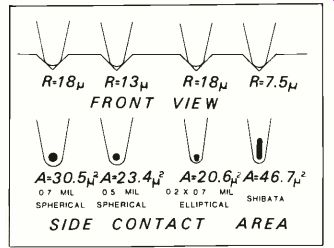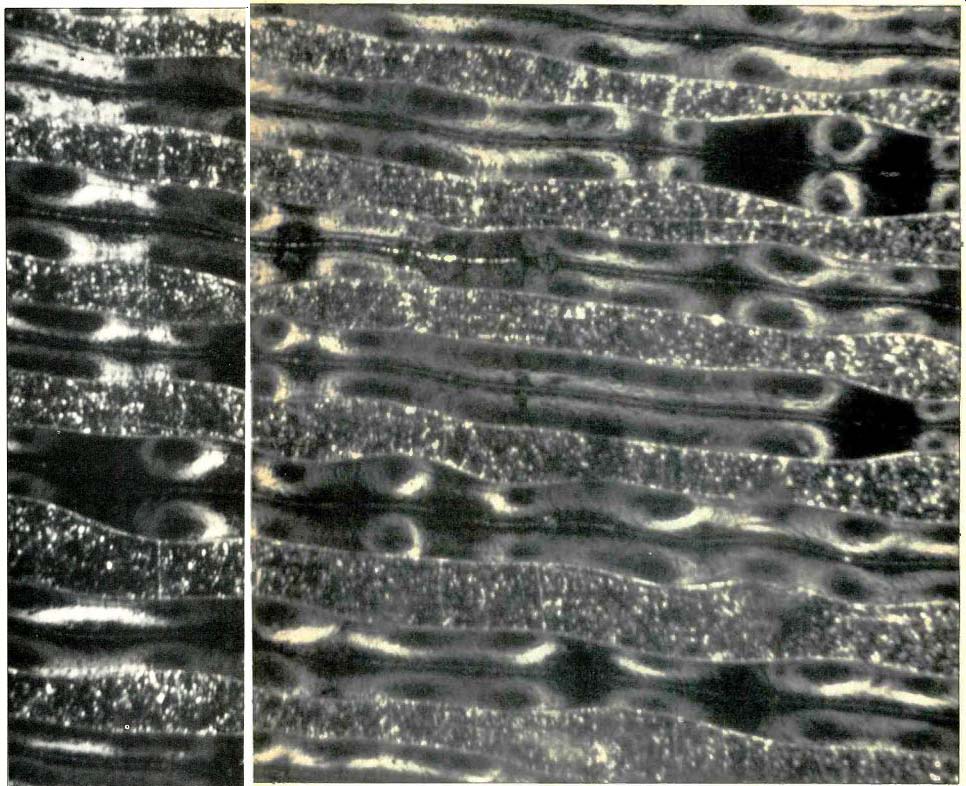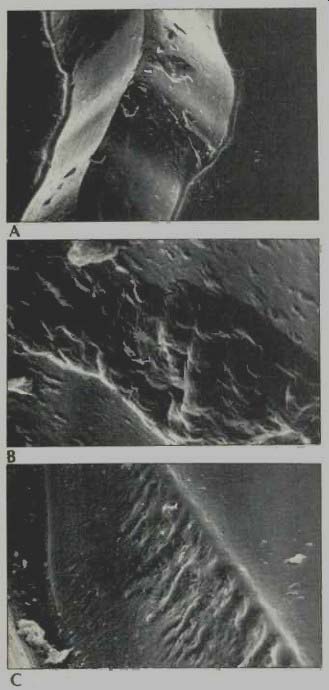by Walter E. Davies [The Last Factory, Livermore, Calif., USA]
This scanning electron microscope study shows the quality of vinyl used to press discs plays a large part in record wear. One primary type of defect is fracturing of the disc surface, which even occurs during the pressing cycle.
The LP record, which made its debut about 30 years ago, brought about a dramatic improvement in sound quality over the shellac-based 78s in addition to providing much more playing time per disc. Following this, the rapid change from sapphire to diamond styli brought the twin benefits of lower record wear and very much longer stylus life. Record wear shows up as a loss in audible sound quality, and the audio industry responded to the problem by choosing quality vinyl mixes for the LP record base and by continually improving tonearms, pickups, stylus designs, and stylus loading characteristics. Today the public has avail able relatively inexpensive but nonetheless high-quality transducer systems. With this excellent equipment widely available, our ears tell us just how marvelous a record can be when it is played for the first time. Then, de pending on the qualities of the record base material, the quality of pickup, and pickup loadings, critical ears can hear loss of sound quality after as few as two to 10 plays. Interested in how records wear and with the ultimate goal of reducing record wear, we have used the scanning electron micro scope (SEM) to help us to see how wear occurs.

Fig. 1--Three stylus types. This illustration shows the relationship of
the moving stylus to the groove walls. The ideal contact areas are shown.
Currently, there are three general stylus designs; these are the spherical, elliptical, and Shibata types (Fig. 1). Note that the elliptical and Shibata de signs were developed to solve particular problems brought about by LP discs and quadraphonic reproduction. With all three of these designs, the pressure on the vinyl remains very high, ranging from 30,000 to 69,000 pounds per square inch with a stylus tracking force of 1 gram. These high pressures have led people to assume that inelastic, permanent or plastic deformation occurred, especially after repeated plays, and also that local melting occurred. The plastic deformation was presumed to be a major factor in loss of sound quality.
Our SEM study shows that deformation is not a terribly important factor in loss of sound quality, but does indicate some other factors that are important. Optical microscopy could not be used for these studies because the optical microscope does not have the depth of field necessary to be able to see other than very small areas of the record surface. As an example, the photo shown in Fig. 2 was taken by reflected, conoscopic illumination--effectively a ring light around the objective lens of the optical microscope.
The view is perpendicular to the record. The hills and valleys on each side of the groove are manifested by changes in reflection. The information on the record groove is not easily read because of the viewing angle (90 degrees). If the viewing angle is changed, the depth of field severely limits the surface area that can be viewed. The depth of field difficulty disappears with the SEM. The SEM photos for this article were taken with an angle of 60 degrees between the viewing electron beam and the record surface. The enormous depth of field allows us to see all of the audio information and, in addition, all of the surface imperfections.
Reading SCM Photos
However, viewing SEM photographs can be frustrating, as they do show a large amount of detail, some of which is important and some of which is not. Thus, interpretation of the photos can be difficult. At times a depression may appear to be a particle lying on the surface, and at times a hill on the surface may appear to be a depression. Turn the magazine upside down and view the low magnification photos. What were grooves now appear to be mountain ridges; concave features appear convex. "Up" and "down" appearances are, to a large extent, psychological phenomena. We learn to identify "up" and "down" by relation ships between objects and the light shining on them. The sun is always up! Only by carefully studying a sequence of SEM photos in light of the back ground knowledge of the spatial relationship between the surface and the electron beam, can one be certain whether one is observing a hill or a valley.
Figures 3 through 5 are three sequences of six photos each, taken of a small area on an individual record with varying magnification. Figure 3 is of a very high-quality, unplayed, audiophile record (Kotekan, which was kindly provided by Reference Recordings, 400 Pennsylvania St., San Francisco, Calif 94101). In the low-magnification pictures, one can see the wealth of audio information, the percussive notes with harmonics are superimposed upon the basic frequency. The width and depth of the groove give amplitude information (loudness). As the magnification is increased, we be gin to see imperfections in the surface of the vinyl. Notice the small perturbances of the surface. It is not smooth. In Fig. 3D and 3E we can also discern several small holes in the groove surface. These are imperfections arising from the pressing operation. There are also holes in the bottom of the groove. These imperfections probably came from the process of releasing the record from the press mold. Since the stylus rides on the sides of the groove, imperfections in the very bottom of the groove do not lead to deterioration of the audio quality.
The Kotekan is a record of superb audio quality. The imperfections seen at high magnification are both of low number density (number per unit area of the groove) and of small size. In these studies of record wear, the number density of imperfections, their sizes, and their types are the important data.
For these tests, all of the records were played with a new Shure M91ED cartridge (elliptical) loaded at 1 gram with proper anti-skate adjustment. The records were cleaned with 50 percent isopropyl alcohol. (Dirt could have caused erroneous interpretation by gouging out the groove surface.) Records had adjacent serial numbers so that they came from the same master and presumably pressed within minutes of one another.
Figure 4 is the sequence of SEM photos of a Kotekan record played 50 times. The loss of audio quality is easily heard. The SEM photos show that there are now many small pieces of vinyl that have come off of the surface. These little depressions are very reminiscent of glass surfaces that have been chipped by fine sand, that is, these imperfections appear to be due to surface conchoidal fractures. Examples of conchoidal fractures are broken or shattered glass. Note that by comparison with Fig. 3, there are many more imperfections of this kind and that their individual sizes are larger than those of Fig. 3. Notice too the distinct wear lines that are parallel to the record groove.

Fig. 2--As optical microphotograph of an un-played Kotekan record. The
information in the groove walls is very difficult to read using this technique,
which uses reflected light via conoscopic illumination.

Fig.3--Scanning electron microscope (SEM) microphotographs of an unplayed
Kotekan record.

Fig. 4--SEM microphotographs of a Kotekan record played 50 times.

Fig. 5--SEM microphotographs of a record of Hoist's The Planets.
Figure 5 is a sequence of SEM photos taken of a record of Hoist's The Planets. This record was also played 50 times. After 50 plays, it is almost unlistenable. The groove walls clearly show enormous damage. Notice that the damage is mainly of the conchoidal fracture type and that there are many longitudinal wear lines. In Figure 5F, we can clearly see why high frequencies become distorted by the wear process. The wall modulations in the right channel are very badly damaged by the conchoidal fracturing that has occurred. In this photo, the dimensions of the fractures are a sizable fraction of the width of the wall modulations.
The wear damage shown in Figs. 4 and 5 is predominantly of the conchoidal fracture type. But this is not the only kind of wear damage that can occur. Figures 6A, B, and C show examples of another kind of wear process, tearing and gouging in addition to the conchoidal fracture, which may be associated with a "stick-slip" frictional phenomenon. These photos were taken from a recording of Rachmaninoff's Symphony No. 1, used as demonstration record in an audiophile specialty house. The pickup was a moving-coil type loaded at 2.5 grams, and the record was thoroughly cleaned prior to each playing.
Several points should be noted from these SEM pictures. First, there is a large difference in wear, depending upon the quality of the vinyl used in the record pressing. The Kotekan is not only a superb recording, but the discs are also made of high-quality vinyl.
Second, the unplayed records have many defects visible under high magnification. It is the number density (number per unit area of the groove) and the sizes of the defects that ac count for the deterioration of audio quality. Third, the smooth lines worn into the side walls produced by the wearing operation probably do not do as much sonic harm as the conchoidal fractures or the tearing and gouging wear.

Fig. 6--SEM microphotographs of a recording of Rachmaninoff's Symphony
No. 1.
The SEM data indicate that, despite the very large unit area loading at the record groove walls, repeated plays do not, in themselves, lead to large permanent deformations of the groove as has been widely presumed. A very strong implication from this data is that, to a large extent, the crackling and popping sounds presumed to be caused by static electricity are caused by the conchoidal fracturing, the tearing, and the gouging wear. There is no question, however, that static electricity is built up in the course of playing a record, but the purely static charge effect appears minor compared to deterioration of audio quality due to the generation of wear defects. Static probably causes more harm by attracting dirt to the playing surface where it subsequently is pushed and pounded into the groove wall or forced along in front of a stylus, scouring and gouging the groove wall.
Pure vinyl is not used in pressing records, rather vinyl with various fillers is used, and variations in the ratio of vinyl to fillers and the dispersion of fillers are common. The conchoidal fracturing wear is indicative of too large a concentration of filler; the tearing and gouging wear is indicative of a poor choice of the type of filler material. SEM data could help the manufacturers develop and provide the consumer with a better product. Although human ears may be able to discern the audio deterioration, they cannot point to the cause.
The SEM is a powerful tool for the detailed study of surfaces. This study points to several mechanisms for wear in phonograph records. It also points to contributing factors that affect the wear processes which are introduced in the manufacturing processes. Microscopic fracturing, gouging, and tearing along with the detrimental effects of surface contamination are mechanical factors contributing to the wear processes. This study also clearly indicates that the quality of the vinyl record base material has an enormous effect on the type of wear and the total quantity of wear.
Much can be and has been done to slow the wearing process. Audio equipment technology has made large strides towards this goal, and the audiophile has become more aware of the importance of cleaning and proper record storage. Some record preservatives are presently being marketed and new ones are about to be introduced to the public, and with the escalating cost of records, these new materials and processes can help keep good mu sic affordable to the consumer.
(Audio magazine, Sept. 1980)
Also see:
RECORD WEAR--The diamond and the rough and what they can do to each other
How Vinyl Records Are Made (Audio, June 1980)